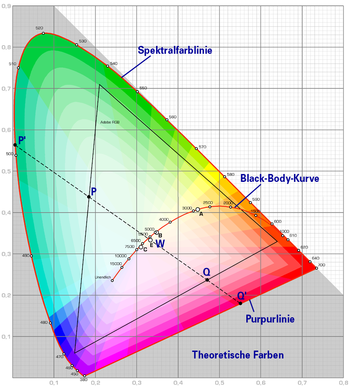Additive base color
The additive basic colors are red , green and blue . With these colors, the colors of the RGB color space can be generated through additive color mixing .

The fact that the color space is roughly parabolic creates technical problems. It has therefore limited itself to editing colors that lie within a triangle. This triangle is shown in gray in the illustration opposite. Colors outside of the triangle cannot be created, as this would require "negative" brightness.
The display device can only produce the colors at the tips of the triangle (red, green and blue), all other colors inside the triangle and on its edges are produced by proportions of the three basic colors.
Examples:
a) Yellow occurs when red and green are equally strong and the blue light source is completely switched off.
b) Orange is produced when red is more bright than green.
c) White is created when all three basic colors shine equally.
The corner points of the triangle are not chosen completely arbitrarily, but are defined by the availability of crystals ( luminescent material ) that produce these colors as soon as they are stimulated to emit light. This excitation takes place in the picture tube of a color television or computer monitor by bombarding it with very fast electrons ( cathodoluminescence ). Color values outside the gray triangle cannot be displayed with such a picture tube. This particularly includes rich green values.
The additive basic colors are used, among other things, in tube monitors , LCD screens and video projectors for displaying images. In digital image processing , the additive basic colors are a method for describing colors.